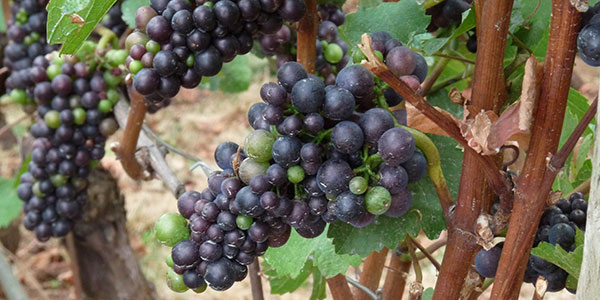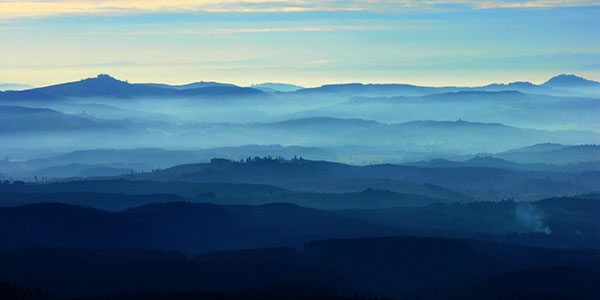Wine Regions
Make a toast to a trio of vintage Beaver State winemaking hotspots
Three communities in Oregon’s world-renowned wine country offer once-in-a-lifetime opportunities to experience the Pacific Northwest in an exciting new way. The Umpqua Valley, Willamette Valley and Roseburg all reap the benefits of fertile land dotted with abundant wildlife, natural attractions, spectacular waterfalls and a legendary merger of two rivers.
Winemaking History
Once European and American settlers, explorers, traders and miners started entering the region, they found it ideal for agriculture. By the 1840s, tens of thousands of people left the East and Midwest, heading west on the Oregon Trail and putting down roots in the Beaver State.

Ethan Prater
Winemaking in this part of Oregon dates back to the 1880s, when German immigrants are said to have planted among the first grape vineyards in the area. Prohibition temporarily stymied the region’s winemaking economy. Growers who dared to continue doing business retreated to private basements and bathrooms until Prohibition’s end. However, when Prohibition was lifted in 1933, viticulture in the region exploded, cementing its place on the winemaking map.
Things to Do
Today, Oregon’s winemaking industry is deeply rooted in the Umpqua and Willamette valleys. Nearly all of some two-dozen wineries in the Roseburg area of the Umpqua Valley are family-owned. The Willamette Valley is home to the majority of Oregon’s famous wineries, and that shouldn’t come as a surprise: The valley sits on the same latitude as the Burgundy wine region of France. Winery tours are available, some with transportation provided. Map out a day to visit wineries and sample some 40-plus varieties of wine. Be sure to check times and schedules.
Named by the Chinook people, Umpqua translates into English as “thundering water.” It’s an apt description: The river is a haven for whitewater enthusiasts, and outfitters are available to give novices and experienced hands alike a chance to ride the rapids.
The North Umpqua River also is known for its fishing, and seasonal runs of salmon and steelhead draw anglers from around the country. Those who are not anglers can watch the fish in their native waters as they swim by a viewing window at Winchester Dam. Whitewater rafting is also popular on the river and rafters flock to test the rapids.

Terry Fennell/BLM Oregon
Umpqua Wilderness
The Umpqua National Forest comprises nearly a million acres in southwest Oregon. The area is known for innumerable recreation opportunities and beautiful waterfalls. The North Umpqua Wild and Scenic River Corridor is a national scenic byway featuring fly-fishing, whitewater rafting and other recreation options. The byway leads to Diamond Lake and extinct volcanoes Mount Thielsen and Mount Bailey. A welcome detour is Crater Lake National Park to the east.
“Colliding Rivers” is the title earned by the collision of the Little River and the North Umpqua River. Eleven miles east of Roseburg, the two rivers merge at a nearly head-on angle, resulting in a turbulent confluence of two strong currents. Housed in the Glide Ranger Station, the Colliding Rivers Information Center offers insights into the geological history of the region and the peoples who have made the area their home.
Shopping opportunities in the wine country region are as diverse as the wine varieties produced. Quaint shops, antique stores and, of course, all things wine, are showcased. Many of the wineries have their own gift shops.
Gathering Together Great Food
Grapes aren’t the only produce found in Oregon’s wine regions. Just outside of Corvallis, Gathering Together Farm in Philomath, Oregon, provides prepared local cuisine at a farmstand dining room.
Gathering Together is a certified organic farm growing a wide array of organic produce. In business since 1987, this family-owned operation boasts a thriving community-supported agriculture program, an on-site farm store and a seasonal restaurant all in one location.
The store not only carries tasty produce, but also homemade pastries, free-range eggs, locally-raised lamb, pasture-raised chicken, Wild Harvest honey, gourmet cheeses and more, all sourced from nearby organic farms. Their homemade potato doughnuts are made fresh every morning—stop by and fuel yourself for a day of exploration in the Willamette Valley.
Gathering Together’s Farmstand restaurant has menus inspired by French and Italian traditions and change frequently based on the abundance of produce and the creativity of their chef. An early summer meal might feature Oregon strawberry sorbet, while late summer brings dishes like stuffed summer squash and caprese salad with fresh-picked basil and heirloom tomatoes.
Gardens Galore
Fans of lush, colorful gardens will find paradise in Salem, Oregon. In this town in the Willamette Valley, many local growers not only showcase their plants for sale, but they have also created awe-inspiring display gardens that will delight visitors.
At the Dellbert Hunter Arboretum and Botanical Garden in Dallas, visitors will find perennials, conifers, oaks, wetland species and even dryland desert plants, thanks to the varied terrain contained within the arboretum.
Sometimes referred to as Salem’s secret garden, the Martha Springer Botanical Garden is located on the campus of Willamette University and offers a quiet place for contemplation and reflection. Opened in 1988 in honor of professor Martha Springer, the 1-acre garden contains 12 smaller gardens stretched along the Mill Race stream that bisects the campus.
No botanical garden tour is complete without a trip to the area’s shining showpiece, The Oregon Garden, an 80-acre botanical wonderland located in Silverton, featuring 20 specialty gardens, a Hobbit House, water features and more. Well-behaved pets on leashes are even welcome to tour the gardens with you.
The Willamette Valley offers one of the finest climates in the world for growing roses, and you’ll find thousands of them displayed on 7 acres of themed gardens at Heirloom Roses in St. Paul. And if you love roses, but growing them seems to be a thorny subject, check out the farm’s Saturday Rose Academy—an on-going series of monthly seminars designed to take the mystery out of growing roses.
Roses and other fair flowers can also be found at Historic Deepwood Gardens, a 4.5-acre English-style garden surrounding Historic Deepwood Estate, created by landscape architects Elizabeth Lord and Edith Schryver in 1929. Deepwood Museum & Gardens feature covered arches and gazebos, ornate fences, and a nature trail that weaves its way through the western border of the property.
Oregon Wonders
Between wine tastings, visitors to the Wilamette Valley can find all manner of adventure. From historic neighborhoods to wildlife refuges, prepare to be dazzled.
Just to the south of Corvallis, visitors will discover the William L. Finley National Wildlife Refuge, situated along foothills of the Coast Range. The refuge encompasses a diverse assortment of habitats and its primary goal is to provide a wintering habitat for geese, especially the dusky Canada goose. It’s a great place for bird watching, nature walks, hiking, photography and more.
Wonders of the man-made variety include Corvallis’ historic downtown with many buildings that date back to the 1800s. This includes the Benton County Courthouse, an iconic building that is also the oldest courthouse in Oregon still used for its original purpose. Today other historic buildings house many locally owned shops and restaurants. These unique buildings add to the overall charm and appeal of the downtown core.
Downtown is bordered by the beautiful Riverfront Commemorative Park, and Benton County is home to three stately covered bridges. Benton County’s final wonder encompasses one of the things the Willamette Valley is most famous for— the local Heart of Willamette Wineries.
For More Information
Oregon Wine Board
503-228-8336
www.oregonwine.org
Travel Oregon
800-547-7842
www.traveloregon.com







